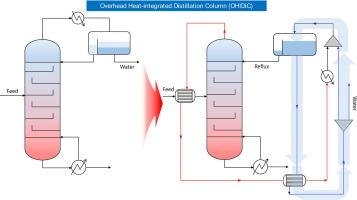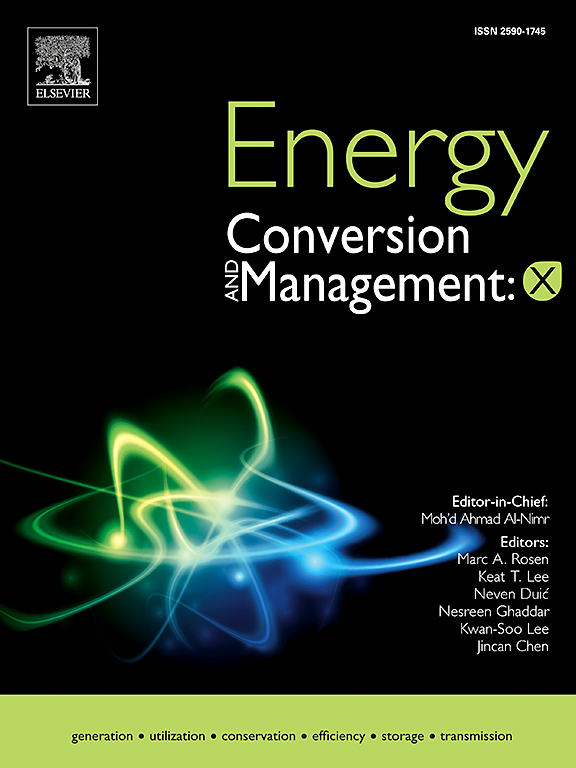自来水循环,通过热集成实现大量能源回收
IF 7.1
Q1 ENERGY & FUELS
引用次数: 0
摘要
本研究介绍了高架热集成蒸馏塔(OHIDiC),这是一种通过多重热交换和产品循环实现热回收最大化的新方法。通过利用高架蒸汽作为直接热源,低温进料水和产品水被用作冷却剂,从而大大降低了冷凝器的工作负荷和对冷却设施的依赖。此外,加热后的进料将热量传递给塔,从而大大减少了再沸器的热负荷。部分加热后的产品水被循环回滗水器,用于产品循环,而其余部分则作为最终产品释放。这种循环过程可确保持续的冷却剂供应,从而降低冷凝器的工作负荷。本研究考虑了两种工艺,即利用系统内非反应分离和反应分离产生的水产品。当应用于水-十二醇混合物的分离时,OHIDiC 比传统蒸馏塔减少了 69.21% 的冷凝器负荷,总功耗减少了 31.46%。在 OHIDiC 中加入反应蒸馏后,较高的顶蒸温度促进了多个热交换段的高热传导,从而显著降低了总热负荷。这使得总热负荷降低了 46.96%,二氧化碳排放量减少了 36.06%。这些研究结果证实,OHIDiC 通过利用工艺衍生物质实现了显著的节能效果,当顶层蒸汽温度升高时,节能效果更加明显。本文章由计算机程序翻译,如有差异,请以英文原文为准。

Circulation of self-supplied water for significant energy recovery through heat integration
This study introduces an overhead heat-integrated distillation column (OHIDiC), a novel approach that maximizes heat recovery by multiple heat exchanges and product circulation. By utilizing the overhead vapor as a direct heat source, low-temperature feed and product water were used as cooling agents, thereby significantly reducing the condenser duty and reliance on cooling utilities. Additionally, the heated feed transfers heat to the column, leading to a substantial reduction of reboiler heat duty. Some of the heated product water is recycled back to the decanter for product cycling, while the rest is released as the final product. This circulation process ensures a continuous coolant supply, which contributes the reduction of condenser duty. Two processes were considered in this study, utilizing the water product from a non-reactive, and from a reactive separation within the system. When applied to the separation of a water-dodecanol mixture, OHIDiC reduced the condenser duty by 69.21% compared to a traditional distillation column, with a 31.46% reduction in the total utility consumption. When reactive distillation was incorporated into the OHIDiC, the higher overhead vapor temperature facilitated high heat transfer in the multiple heat exchange sections, thereby significantly reducing the total thermal load. This resulted in a reduction of up to 46.96% in total heat duty and a 36.06% decrease in CO2 emissions. These findings confirm that the OHIDiC achieves significant energy savings through the utilization of process-derived substances, with pronounced benefits when the temperature of the overhead vapor becomes higher.
求助全文
通过发布文献求助,成功后即可免费获取论文全文。
去求助
来源期刊

Energy Conversion and Management-X
Multiple-
CiteScore
8.80
自引率
3.20%
发文量
180
审稿时长
58 days
期刊介绍:
Energy Conversion and Management: X is the open access extension of the reputable journal Energy Conversion and Management, serving as a platform for interdisciplinary research on a wide array of critical energy subjects. The journal is dedicated to publishing original contributions and in-depth technical review articles that present groundbreaking research on topics spanning energy generation, utilization, conversion, storage, transmission, conservation, management, and sustainability.
The scope of Energy Conversion and Management: X encompasses various forms of energy, including mechanical, thermal, nuclear, chemical, electromagnetic, magnetic, and electric energy. It addresses all known energy resources, highlighting both conventional sources like fossil fuels and nuclear power, as well as renewable resources such as solar, biomass, hydro, wind, geothermal, and ocean energy.
 求助内容:
求助内容: 应助结果提醒方式:
应助结果提醒方式:


